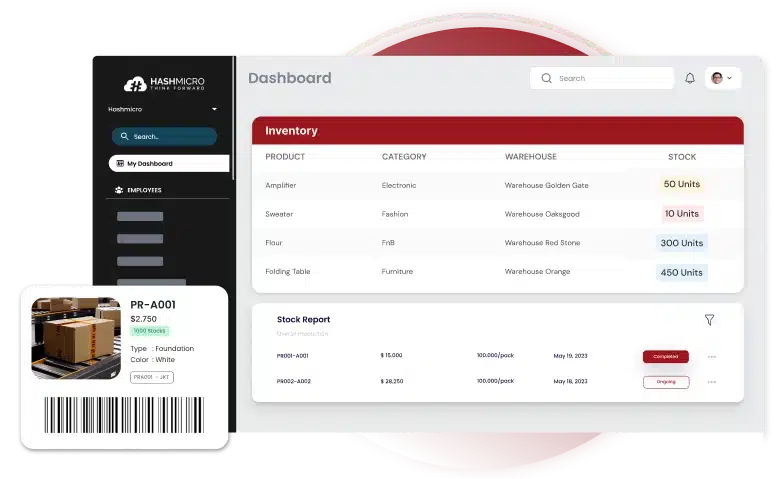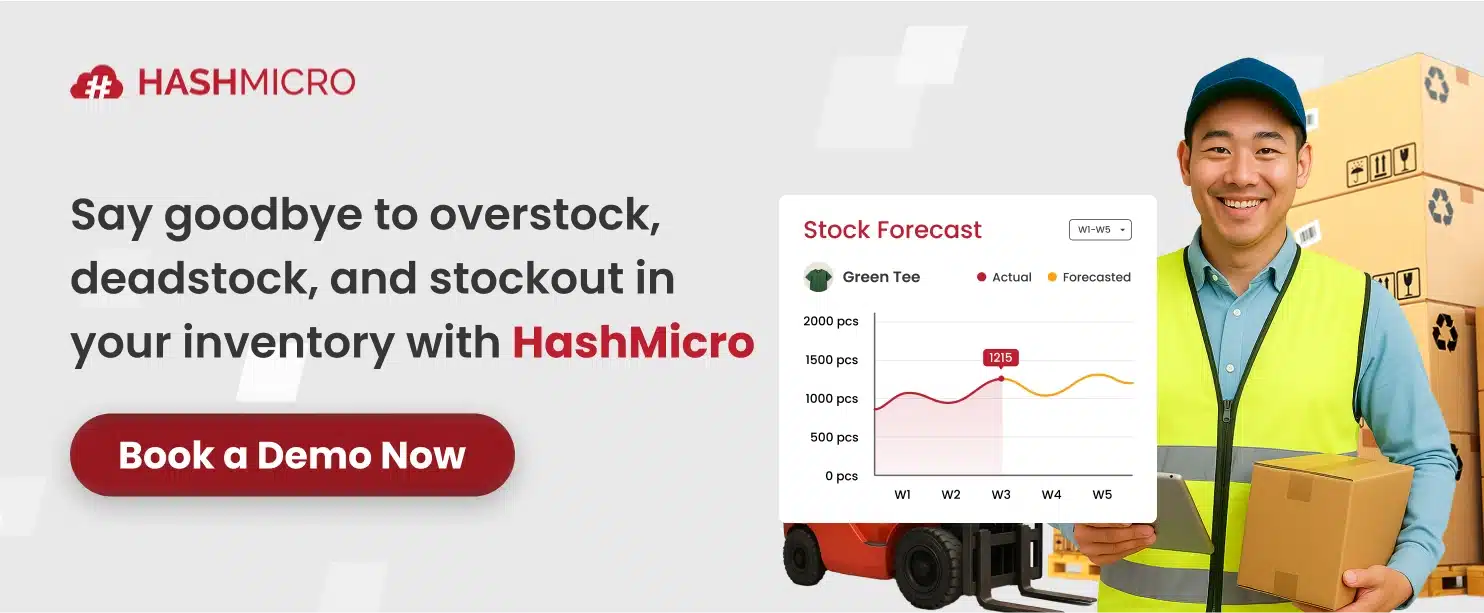A perpetual inventory system is a method that helps businesses overcome inefficient inventory management by eliminating manual tracking and preventing stockouts through real-time accuracy. This approach ensures smoother operations and better control over stock movement.
From my experience, it transforms inventory management with instant updates whenever stock moves. HashMicro Inventory Management Software takes this further with advanced features like Barcode Management, Lot and Serial Tracking, Forecasting, and Stock Aging Analysis to automate and integrate inventory processes seamlessly. Want to experience the difference? Try our free demo today!
Key Takeaways
|
What is Perpetual Inventory?
A perpetual inventory system is a real-time accounting method that continuously records stock movements, eliminating the need for physical counts. It works by automatically updating inventory data through integrated tools, such as POS systems and barcode scanners, whenever a sale or purchase occurs.
I often use the perpetual inventory system in businesses that handle large volumes of stock, such as retail, warehousing, and manufacturing. For companies like mine with multiple locations or frequent transactions, this system helps maintain accurate inventory control, minimize errors, and boost operational efficiency.
What is a Perpetual Inventory System?
A perpetual inventory system is a real-time method of tracking stock levels using tools like barcode scanners, point-of-sale (POS) systems, and inventory software. Every time you sell, restock, or adjust inventory, the system updates automatically. This eliminates the need for manual stock counts and ensures you always have an accurate view of your inventory.
For business owners and managers like me, this means no more guessing about stock levels or dealing with costly errors. With perpetual inventory, I can avoid stockouts, reduce overstocking, and make smarter purchasing decisions. It’s a game-changer for businesses with fast-moving inventory, like retail stores and manufacturers, helping me stay efficient and ahead of the competition.
Hashy AI Fact

Need to Know
AI automates inventory management, improving visibility and control. AI for Inventory Management enables accurate demand forecasting, tracks stock levels in real time, and minimizes excess or shortage, helping businesses reduce holding costs and improve fulfillment speed.
Request a free demo today!
How Perpetual Inventory System Works
My perpetual inventory system updates stock automatically every time I make a sale, receive new items, or adjust the inventory. With barcode scanners, POS systems, and inventory software handling updates instantly, I always know exactly what’s in stock.
Here’s how it works:
- Sales: When a sale is made, the item is instantly deducted from the system, updating stock levels in real-time. This helps businesses track fast-moving products and spot low-stock items quickly. It also supports accurate sales reporting and demand forecasting.
- Restocking: When new inventory arrives, items are scanned and immediately added into the system. This ensures that stock levels are updated without delay, minimizing gaps between receiving goods and having them available for sale. It also helps prevent errors that often occur with manual entry.
- Adjustments: Any inventory changes, such as product returns, damages, or internal use, are recorded right away. Real-time updates keep inventory data accurate and reflect the true stock condition. This allows businesses to react quickly to discrepancies and maintain reliable stock records.
This real-time tracking ensures accurate inventory levels, helping me avoid stockouts or overstocking and making it easier to manage my business efficiently.
Advantages of Perpetual Inventory System

Effective inventory management is crucial for informed decision-making, and I rely on the perpetual inventory system to achieve this. By continuously updating stock data through automated inventory software, I can streamline operations and maintain accurate, real-time warehouse visibility.
Here are four key benefits:
1. Real-Time updates
A cloud based inventory system provides real-time updates, automating the tracking of purchases and sales while keeping data accessible anytime and anywhere. It ensures all inventory information stays synchronized across devices and locations for seamless management.
2. More Informed Forecasting
A perpetual inventory system helps you analyze customer buying patterns, enabling more effective sales strategies and accurate stock planning. It also prevents overstocking or stock shortages that could lead to potential losses.
3. Managing Multiple Locations Easily
Managing inventory across multiple locations can be challenging, but an inventory system simplifies this process by centralizing data and automating monitoring. It allows you to track stock levels and supply needs efficiently, preventing shortages in any outlet.
4. Facilitates Preparation of Financial Statements
Finally, an inventory system simplifies financial report preparation by automatically recording stock quantities and values in real-time. This ensures faster, more accurate reporting while minimizing errors from manual calculations.
Disadvantages of Perpetual Inventory System
While my inventory system offers many advantages, I understand the importance of recognizing its potential limitations to anticipate issues effectively. Still, I find that the benefits far outweigh the drawbacks, making the perpetual inventory system a valuable investment for my business.
Here are the disadvantages of a perpetual inventory system that you must pay attention to:
1. Loss of items
The first disadvantage is the vulnerability to loss of items. This system does have a function to ensure quick and easy inventory recording. However, the absence of physical checks in this system has the potential to result in the loss of goods and can lead to company losses.
2. Scanning errors
One of the essential components of a perpetual inventory system is that each item must have a unique barcode. The presence of a barcode or tag on each item makes it easier for you to scan all items. Suppose an error occurs in the scanning system or is to be detected. In that case, the company will not record the item in the system.
3. Improper inventory tracking
The main problem in the inventory system is improper inventory tracking. If this happens, tracking the company’s goods and inventory in the warehouse or store will hamper your business operations. Therefore, you can use effective and efficient backups to support recording in the perpetual inventory system.
4. Hacking
One primary concern with a perpetual inventory system is the risk of hacking, which can compromise sensitive company data and information. To maintain credibility and system reliability, it’s essential to implement strong data security measures.
5. Theft
Another drawback of a perpetual inventory system is its vulnerability to theft, which can distort stock records and negatively impact company performance. To prevent this, businesses must enforce strict security and inventory control procedures.
Also read: Top Inventory Management Software Systems in Singapore
Example of Perpetual Inventory System
My company, ABC Electronics, specializes in selling laptops. Each laptop costs me $800 to purchase from the supplier and sells for $1,200 to customers. I use a perpetual inventory system to track every movement of stock.
Step 1: Initial Purchase
ABC Electronics buys 100 laptops from the supplier, and the system instantly updates the records. The inventory now shows 100 units available with a total value of $80,000, calculated from the purchase cost of $800 per laptop.
| Date | Transaction | Units In | Units Out | Balance Units | Balance Value | COGS |
| Jan 1 | Purchase | 100 | 0 | 100 | $80,000 | – |
Step 2: First Sale
A customer buys 10 laptops with a total selling price of $12,000. At the same time, the system records the cost of goods sold (COGS) of $8,000 and automatically updates the inventory, leaving 90 laptops remaining in stock.
| Date | Transaction | Units In | Units Out | Balance Units | Balance Value | COGS |
| Jan 1 | Purchase | 100 | 0 | 100 | $80,000 | – |
| Jan 5 | Sale | 0 | 10 | 90 | $72,000 | $8,000 |
Step 3: Additional Purchase
ABC Electronics purchases an additional 50 laptops at the same cost of $800 each. The system immediately updates the records, bringing the total inventory to 140 units with a new overall value of $112,000.
| Date | Transaction | Units In | Units Out | Balance Units | Balance Value | COGS |
| Jan 10 | Purchase | 50 | 0 | 140 | $112,000 | – |
Step 4: Second Sale (Mixed Units)
A customer purchases 20 laptops for a total selling price of $24,000. The system instantly records the cost of goods sold at $16,000 and updates the inventory, leaving 120 laptops in stock.
| Date | Transaction | Units In | Units Out | Balance Units | Balance Value | COGS |
| Jan 15 | Sale | 0 | 20 | 120 | $96,000 | $16,000 |
Step 5: Return Transaction
A customer returns 2 laptops, and the system immediately updates the inventory by adding the units back. This brings the total stock to 122 laptops valued at $97,600, while the cost of goods sold is also adjusted automatically.
| Date | Transaction | Units In | Units Out | Balance Units | Balance Value | COGS |
| Jan 20 | Customer return | 2 | 0 | 122 | $97,600 | -$1,600 |
How to Implement a Perpetual Inventory System
As someone who relies heavily on accurate stock data, I find that implementing a perpetual inventory system transforms how I manage resources. With automation, integration, and real-time insights, I can make faster, data-driven decisions that keep my business running efficiently.
- Set up automated tracking tools
To start, install POS terminals, barcode scanners, and perpetual inventory software to automatically record every stock movement. This setup ensures real-time updates without manual input, improving accuracy and efficiency. - Maintain accuracy with cycle counting
Even with automation, regular cycle counting is essential to verify data accuracy. It helps detect discrepancies early and ensures that your digital records reflect actual stock levels. - Integrate inventory management methods
A perpetual system works best when combined with methods like JIT, MRP, EOQ, and DSI. These integrations optimize stock control, helping to balance inventory levels based on demand and cost efficiency. - Automate Cost of Goods Sold (COGS) calculation
The system automatically updates COGS with every sale, providing a clear view of production costs in real time. This eliminates the delays associated with manual calculation and ensures the accuracy of financial data. - Estimate gross profit continuously
With real-time COGS data, businesses can instantly track their gross profit after each transaction. This enables managers to make informed decisions and respond promptly to changes in costs or demand. - Connect with ERP and accounting systems
Integrating the perpetual inventory system with ERP or accounting software centralizes all operational data, streamlining the process. This connection enhances visibility, improves reporting, and supports strategic business planning.
Perpetual vs. Periodic Inventory: Key Differences Explained
I’ve found that the perpetual inventory system and the periodic inventory system are two common methods for managing stock. Still, they differ significantly in how they track and update inventory data. Here are the key differences I’ve observed between perpetual and periodic inventory:
| Aspect | Perpetual Inventory System | Periodic Inventory System |
|---|---|---|
| Stock Management | Continuously updated inventory levels in real time. | Relies on manual stock counts conducted at specific intervals, such as monthly or annually. |
| Accuracy | Provides a constant view of stock levels, making it easier to avoid stockouts or overstocking. | Can lead to discrepancies, as inventory changes between counts may not be accounted for. |
| Cost | Higher initial costs due to the need for technology like barcode scanners and inventory management software. | Lower initial costs, as it relies on periodic physical counts without the need for advanced technology. |
Choosing the right method depends on your business needs. If you manage high volumes of transactions or need precise stock data for decision-making, the perpetual system is ideal. However, if you run a smaller operation with less frequent inventory changes, the periodic system may be a practical and budget-friendly option.
Best Practices for Perpetual Inventory System

Now that I understand the advantages and disadvantages of the perpetual inventory system, I can determine the right time to implement it. I know I must use this method if I want to scale my business effectively.
I also need to consider the size of my products and profit margins to ensure the system fits my operations. This helps me transform my business into an inventory-based model efficiently. To achieve this, I must also make sure I’m working with the right vendor who can deliver a sophisticated inventory management solution.
The best suppliers not only support my implementation but also help solve operational challenges. I can consult with the best ERP software and inventory system providers to choose the ideal time and solution for adopting this system.
“A perpetual inventory system provides real-time stock visibility, minimizes errors, and helps businesses optimize cash flow and inventory turnover efficiently.”
— Angela Tan, Regional Manager
Conclusion

The perpetual inventory system provides real-time tracking and accurate stock visibility, helping businesses prevent stockouts and overstocking while efficiently meeting customer demands. Although it requires investment in setup and maintenance, an integrated ERP system can effectively streamline and manage these challenges.
If I were to implement a perpetual inventory management software that delivers real-time updates and reduces manual errors, HashMicro’s Inventory System would be the right choice for my business.
With the CTC Grant, I can receive up to 70% funding support for implementation, making it even more worthwhile. I’ll start the free trial today to experience how it optimizes my inventory management and drives business growth.

FAQ about Perpetual Inventory System
-
What is the difference between perpetual and periodic inventory system?
A perpetual inventory system is constantly updated as each sale / order happens; AKA perpetually updating the data. A periodic inventory system is updated manually after each accounting period; AKA periodically updating the data.
-
Does perpetual inventory use Lifo or FIFO?
In a perpetual inventory system, cost flow assumptions like FIFO (First-In, First-Out), LIFO (Last-In, First-Out), and average cost are essential for tracking. FIFO sells the oldest inventory first, impacting COGS with older prices, while LIFO sells the newest inventory first, reflecting newer prices in COGS.
-
How does a perpetual inventory system work?
Perpetual inventory is a continuous accounting practice that records inventory changes in real-time, without the need for physical inventory, so the book inventory accurately shows the real stock.














